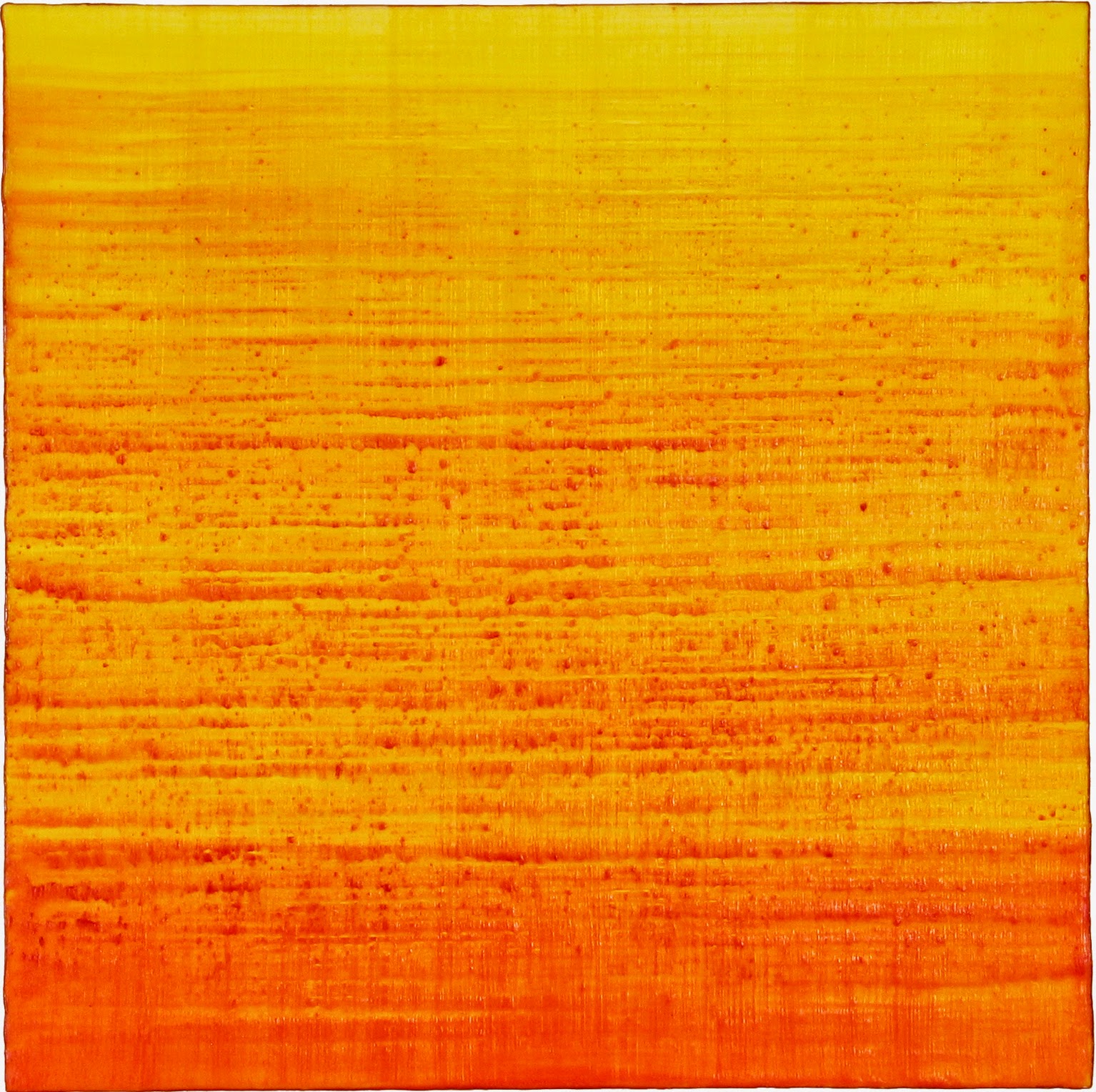"A result of living year-round on Cape Cod and
teaching in Boston resonates with the way Nature and Culture interact."
Melt, 2014, watercolor and mixed media on panel, 18 x 18 inches
About the Work
In these
new abstract paintings in watercolor on wood panels, a classical European
technique used by Vermeer and Rembrandt, called underpainting, is reconfigured
for a contemporary dialogue of Nature versus Culture. Materials become
metaphors. As sunlight illuminates stained glass, an underpainting is a layer
of dark and light –thick and thin tones -over which transparent color is
applied for a luminous effect.
Here, the
underpainting is made visible: it erupts through and interacts with the painted
surface in order to form a literal and metaphoric response or disconnect
between Nature and Culture. The underpainting represents Nature–raw, thick and
unruly–while the vertical stripes equal culture.
The
materials are metaphors and used in a non-traditional way: the underpainting or
support for the paintings is built-up in successive layers of acrylic mediums
mixed with volatile additives such as stone, soda ash, and glass. Humidity and
chemistry, different mediums and mixtures react in unforeseen ways that are not
always understood until dried. Each layer requires different drying times and
results in organic shapes similar to geological formations.
No
conscious attempt to replicate the surface look of Nature is made. However, a
result of living year-round on Cape Cod and teaching in Boston resonates with
the way Nature and Culture interact, are visualized and separate. The material
process of making these paintings engages chance operations –a certain
letting-go of ego or individual choice -and the resulting textures become
metaphors for climatic and geological change or, are transformative change
itself.
Verdant/Oxidized, 2014, watercolor and mixed media on panel, 12 x 12 inches

Erode/Corrode, 2014, watercolor and mixed media on panel, 12 x 12 inches
Aqueous/Viscous, 2014, watercolor and mixed media on panel, 12 x 12 inches

Thaw, 2014, watercolor and mixed media on panel, 20 x 16 inches
Reflecting on Cape Cod
Since
the 1950s, I’ve observed many changes on Cape Cod: Introduced to Cape Cod, as a
child through the marine science community in Woods Hole where my friend’s
father was a ‘summer scientist’ at Marine Biological Lab (MBL), I saw the ocean
differently. The drive from Boston on Route 3 was one lane with sand
drifts that stalled cars until scientists discovered that pines planted in sand
firmed the soil then beach grass grew, this reduced sand drifts and stalled
cars.
My
first impression of Cape Cod was the marine science community where I met
luminaries of the arts and sciences alongside abundance of heat, sand, water
and pines. The importance of marine science to the world can’t be
overstated as we face climate change. Since my 2001 move to the Cape, I’ve
attended science lectures in Woods Hole at MBL, WHOI and the National Academy
of Science. In 2010, I curated an off-Cape exhibit with a science seminar:
Extinct! Endangered Species and Habitats will have companion exhibit in 2016.
Early
70s, in Provincetown with artist friends from Boston, the Cape was a summer
retreat given a historical perspective by my maternal grandparents:
. In the 1920s, newly wed, my grandparents ran guest inn, Eight Bells, in
Provincetown, home to Provincetown Players (1915-1929) and, playwright Eugene
O’Neil alongside notable writers and artists. Provincetown Players “wintered” in
New York City.
Over
the next decades, in every season, I visited friends in Falmouth and
Provincetown.
In
2001, I bought a home and built a studio on upper Cape Cod, a direct result of
Boston’s gentrification. Life on Cape continued as if I was in Boston: I work
in my studio and exhibit; write a column about the arts published in Europe;
curate exhibits and, teach painting in Boston at the School of the Museum of
Fine Arts/Tufts University.
Changes on Cape Cod over six decades include:
. Changing
coastlines
. Climate
change fostered a new ecosystem and economy: More snowfall. Humid summers
defined as tropical in meteorological terms
. New
climates altered migratory patterns of non-native birds and an excess seals both
drawn by Cape’s warmer air and waters that also brought sharks
. The
decline of Cod and the Cape's fishing industry
. More
tourists, more year-round residents and more culture
Climate
change as much as my move from the city to a seaside community has changed my
focus and my artwork.
Inspiration?
Cape Cod’s science community, climate change and nature, in that order:
. Light
on water inspired over a decade of writing and fascination with glass as art.
Water’s fluidity and geological layers inspired watercolors
. Climate
change on Cape Cod –extreme winter storms, tropical bird songs, extreme
textures of moss and ice on trees, flooded coastlines -all these natural events
and raw textures have inspired metaphors (and, realities) in my new paintings
and photography
. Concurrent
with abstract paintings exhibited at Cape Cod Museum of Art, I continue to make
artwork reflective of contemporary social issues and phenomena in many media
Of
Cape’s many attributes, I’ve always associated Cape Cod with marine science in
Woods Hole, culture in Provincetown and nature in New England’s four seasons.

Stardust, 2014, watercolor and mixed Media on panel, 12 x 12 inches
Cenote, 2014, watercolor and mixed media on panel, 12 x 12 inches

































.jpg)

.jpg)

.jpg)
.jpg)













